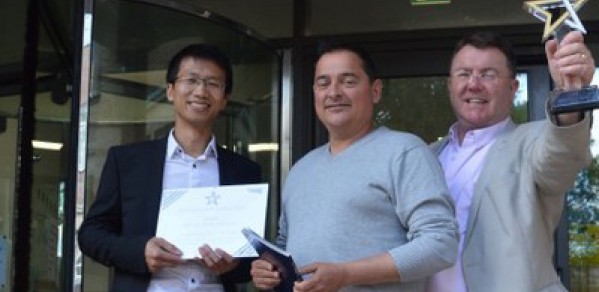
Fibre optic sensing systems designed by Cambridge Centre for Smart Infrastructure and Construction (CSIC) for Hooley Cutting, which carries the main railway line from London to Brighton through the North Downs, won the Best Use of Technology award at the Rail Partnership Awards.
This award demonstrate the benefits of working collaboratively with industry partners to develop solutions to real industry challenges. We are delighted to win this Rail Partnership award.
Jennifer Schooling OBE, Director of CSIC
The prestigious award recognises the use of innovative technologies to help transform Britain’s railway, demonstrating new ways of working, cutting-edge technologies or novel approaches that benefit users.
CSIC's winning ‘Smart Railway Internet of Infrastructure’ project features two fibre optic sensing systems designed and trialled for the 30m-deep cutting slopes. Susceptible to landslides, the slopes require measures to prevent rockfall reaching the tracks, a problem that has caused train derailments and line closures in the past.
Network Rail commissioned CSIC to devise a solution to the problem, and South East Region Managing Contractor Bam Nuttall and ground engineering company Bam Ritchies joined the project team; both organisations have extensive experience of trackside installation and management. The systems use the rate of strain change produced by rockfall in the debris-collecting mesh to help identify and predict problematic areas before they lead to mesh failure.
Philip Keenan, CSIC Business Development Manager, who led the project said: “This award recognises the Best Use of Technology and we are delighted that our fibre optic sensing systems for Hooley Cutting has won this category. Working with Network Rail, Bam Nuttall and Bam Ritchies enabled CSIC to develop an innovative solution to the problem of rockfall at this location, which has been problematic in the past, causing disruption to the network and presenting potential safety issues.
“Using our solution, engineers are only required to investigate locations the system has alerted them to, saving time and reducing risk. Safety is enhanced as the sensors can be incorporated into a system that will alert train drivers. By using sensing systems and real-time data, better decisions can be made around intervention and action.”
Jennifer Schooling OBE, Director of CSIC, said: “This award demonstrate the benefits of working collaboratively with industry partners to develop solutions to real industry challenges. We are delighted to win this Rail Partnership award.”
Another CSIC monitoring project, Structural Health Monitoring Systems’ (a collaboration between CSIC, AECOM, Network Rail and the Alan Turing Institute (ATI)) which showcases two bespoke monitoring systems designed for a masonry arch bridge and viaduct, both in Yorkshire, was also shortlisted for the Railway Partnership Awards.
To read the full case study of ‘Smart Railway Internet of Infrastructure’ see the CSIC Annual Review 2019 which was published at the end of June ahead of the International Conference on Smart Infrastructure and Construction held on 8 to 10 July 2019.
CSIC is an Innovation and Knowledge Centre funded by EPSRC, Innovate UK and industry. CSIC develop cutting edge sensing and data analysis models to provide a powerful platform for delivering data to enable smarter whole-life asset management decisions, for both new infrastructure and existing assets. CSIC collaborates with partner organisations across policy, standards and industry adoption to effect transformative change, deliver benefits to all stakeholders and establish the UK as a global leader in digital construction.

